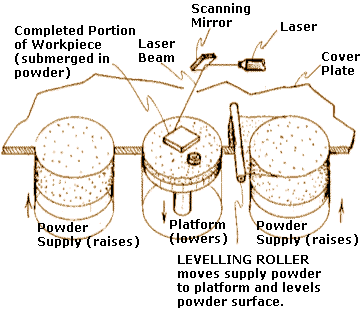Highlights of Selective Laser Sintering
• Patented in 1989.
• Considerably stronger than SLA; sometimes structurally functional parts are possible.
• Laser beam selectively fuses powder materials: nylon, elastomer, and soon metal;
• Advantage over SLA: Variety of materials and ability to approximate common engineering plastic materials.
• No milling step so accuracy in z can suffer.
• Process is simple: There are no milling or masking steps required.
• Living hinges are possible with the thermoplastic-like materials.
• Powdery, porous surface unless sealant is used. Sealant also strengthens part.
• Uncured material is easily removed after a build by brushing or blowing it off.
Selective Laser Sintering
Selective Laser Sintering (SLS®, registered trademark by DTM™ of Austin, Texas, USA) is a process that was patented in 1989 by Carl Deckard, a University of Texas graduate student. Its chief advantages over Stereolithography (SLA) revolve around material properties. Many varying materials are possible and these materials can approximate the properties of thermoplastics such as polycarbonate, nylon, or glass-filled nylon.
As the figure below shows, an SLS® machine consists of two powder magazines on either side of the work area. The leveling roller moves powder over from one magazine, crossing over the work area to the other magazine. The laser then traces out the layer. The work platform moves down by the thickness of one layer and the roller then moves in the opposite direction. The process repeats until the part is complete.

SLA vs. SLS: A Summarized Comparison
Material Properties: The SLA (stereolithography) process is limited to photosensitive resins which are typically brittle. The SLS® process can utilize polymer powders that, when sintered, approximate thermoplastics quite well.
Surface Finish: The surface of an SLS® part is powdery, like the base material whose particles are fused together without complete melting. The smoother surface of an SLA part typically wins over SLS® when an appearance model is desired. In addition, if the temperature of uncured SLS® powder gets too high, excess fused material can collect on the part surface. This can be difficult to control since there are so many variables in the SLS® process. In general, SLA is a better process where fine, accurate detail is required. However, a varnish-like coating can be applied to SLS® parts to seal and strengthen them.
Dimensional Accuracy: SLA is more accurate immediately after completion of the model, but SLS® is less prone to residual stresses that are caused by long-term curing and environmental stresses. Both SLS® and SLA suffer from inaccuracy in the z-direction (neither has a milling step), but SLS® is less predictable because of the variety of materials and process parameters. The temperature dependence of the SLS® process can sometimes result in excess material fusing to the surface of the model, and the thicker layers and variation of the process can result in more z inaccuracy. SLA parts suffer from the "trapped volume" problem in which cups in the structure that hold fluid cause inaccuracies. SLS® parts do not have this problem.
Support Structures: SLA parts typically need support structures during the build. SLS® parts, because of the supporting powder, sometimes do not need any support, but this depends upon part configuration. Marks left after removal of support structures for parts cause dimensional inaccuracies and cosmetic blemishes.
Machining Properties: In general, SLA materials are brittle and difficult to machine. SLS® thermoplastic-like materials are easily machined.
Size: SLS® and SLA parts can be made the same size, but if sectioning of a part is required, SLS® parts are easier to bond.
Investment Casting: The investment casting industry has been conservative about moving to RP male models, so SLS® models made from traditional waxes, etc. are preferred. 3D Systems has a process (dubbed "QuickCast™") which allows SLA models to be more suitable for investment casting. Since SLA resins do not melt but burn to form ash, QuickCast™ modifies the build process so that the interior of the model is hollow with a supporting latticework. When the ceramic is fired, the QuickCast™ model collapses and any ash is minimal because of the small total quantity of material.

